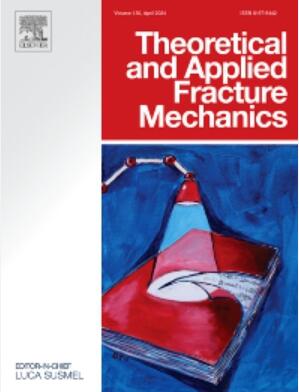水力压裂中油水两相流和混合模式裂缝传播的改进相场模型
IF 5
2区 工程技术
Q1 ENGINEERING, MECHANICAL
引用次数: 0
摘要
提出了一种改进的新型相场模型来描述裂缝的扩展,有效地描述了油水两相流体与固体以及混合模式压裂之间的相互作用。该模型包含两相流应力平衡方程、流体流动方程以及两相流特有的复合模式压裂相场方程。在流体流动方程中,考虑了基质中流体流失过程中油水界面造成的毛细管压力,并将流体流动过程中各向异性的相对渗透率与归一化饱和度联系起来。相场中裂缝扩展的驱动力分为模式 I 和模式 II 驱动力,其中油水两相流体的作用属于模式 I(拉伸)驱动力。该模型使用有限元数值离散化和牛顿-拉斐森迭代法建立数值迭代格式,采用隐式-显式交错求解方案。此外,该模型还用于研究几个关键因素。它评估了不同交角对天然多孔介质中断裂传播的影响。它还研究了不同天然断裂渗透率对水力断裂传播的影响。最后,该模型分析了不同射孔相位角下水力压裂的传播模式。本文章由计算机程序翻译,如有差异,请以英文原文为准。
An improved phase-field model for oil–water two-phase flow and mixed-mode fracture propagation in hydraulic fracturing
An improved novel phase-field model is proposed for describing fracture propagation, effectively characterizing the interactions between oil–water two-phase fluids and solids as well as mixed-mode fracturing. This model encompasses equations for two-phase flow stress balance, fluid flow, and a complex mode fracture phase-field specific to two-phase flow. Within the fluid flow equations, the capillary pressure caused by the oil–water interface during the fluid loss process in the matrix is accounted for, and the anisotropic relative permeability during fluid flow is linked to normalized saturation. The driving forces for fracture propagation in the phase-field are categorized into Mode I and Mode II forces, with the contribution from the oil–water two-phase fluid attributed to the Mode I (tensile) driving force. The model uses finite element numerical discretization and the Newton-Raphson iterative method to establish a numerical iteration format, employing an implicit-explicit staggered solution scheme. Additionally, the model is used to investigate several key factors. It assesses the impact of different intersection angles on fracture propagation in naturally porous media. It also studies the effect of different natural fracture permeabilities on hydraulic fracture propagation. Finally, the model analyzes the propagation patterns of hydraulic fractures under different perforation phase angles.
求助全文
通过发布文献求助,成功后即可免费获取论文全文。
去求助
来源期刊

Theoretical and Applied Fracture Mechanics
工程技术-工程:机械
CiteScore
8.40
自引率
18.90%
发文量
435
审稿时长
37 days
期刊介绍:
Theoretical and Applied Fracture Mechanics'' aims & scopes have been re-designed to cover both the theoretical, applied, and numerical aspects associated with those cracking related phenomena taking place, at a micro-, meso-, and macroscopic level, in materials/components/structures of any kind.
The journal aims to cover the cracking/mechanical behaviour of materials/components/structures in those situations involving both time-independent and time-dependent system of external forces/moments (such as, for instance, quasi-static, impulsive, impact, blasting, creep, contact, and fatigue loading). Since, under the above circumstances, the mechanical behaviour of cracked materials/components/structures is also affected by the environmental conditions, the journal would consider also those theoretical/experimental research works investigating the effect of external variables such as, for instance, the effect of corrosive environments as well as of high/low-temperature.
 求助内容:
求助内容: 应助结果提醒方式:
应助结果提醒方式:


